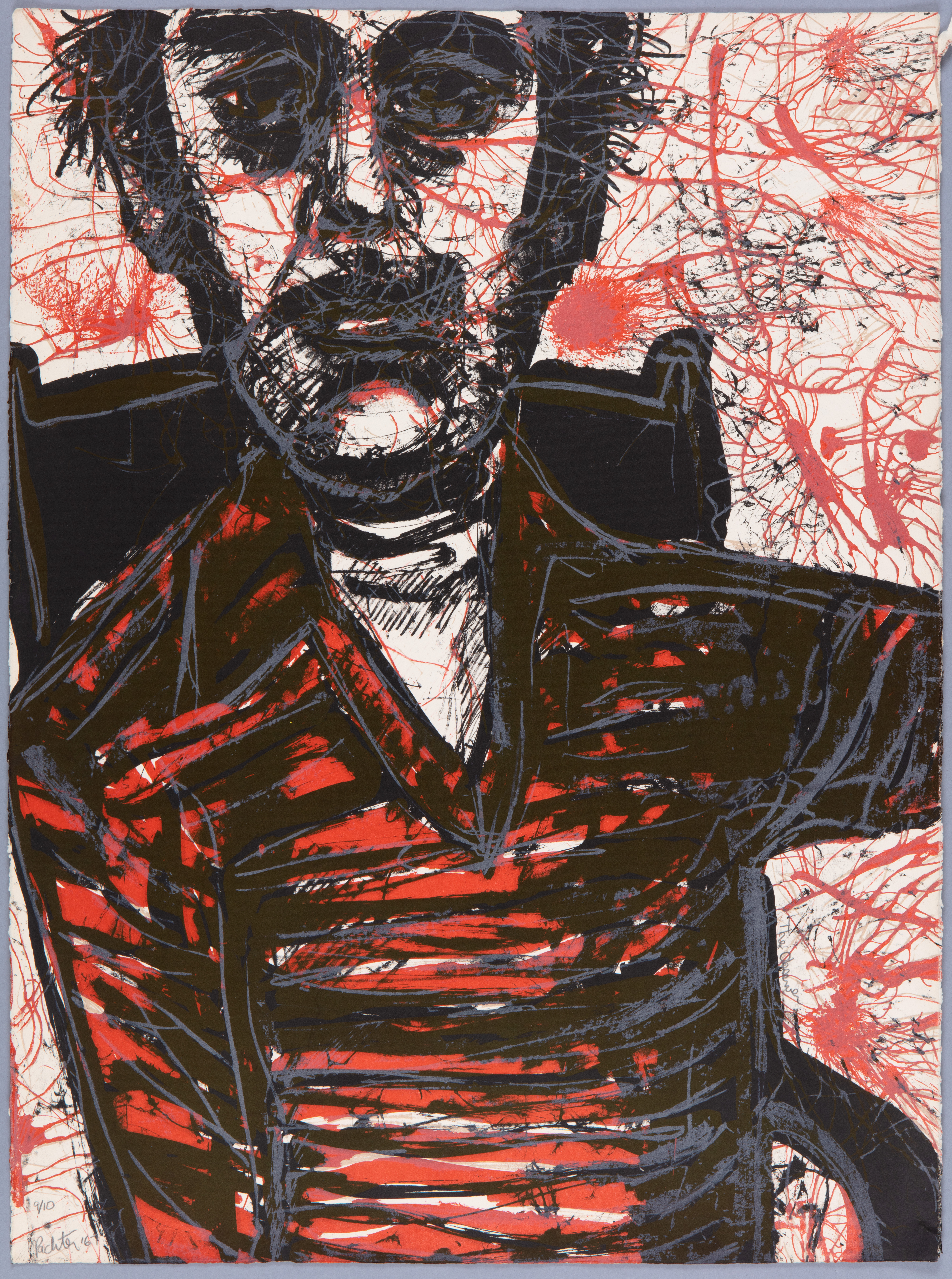Art in Focus: “The Observer” by Charles Pachter

"The Observer," 1967; Ink on paper, lithograph; Charles Pachter OC OOnt DFA LLD: Born Toronto, Ontario, 1942; University of Alberta Museums, University of Alberta Museums Art Collection; 2019.5.32
Charles Pachter is best known today for his impact on Canadian contemporary art from his colourful depictions of national pop-culture symbols. Behind this success, however, is a lengthy evolution of Pachter's style, beginning with the hauntingly experimental works from his early career. The Observer (2019.5.32), housed in the University of Alberta Museums Art Collection, is a lithograph that serves as a tool to unravel the profound connections between Pachter's early expressionist works and his later transition to pop art. Furthermore, it showcases the artist's youthful explorations of self-consciousness through his versatility and boundless creativity.
The Canadian flag, moose, and perhaps most famously, the Queen riding a moose are all well known subject matter to Charles Pachter. Yet these were not always his focus, as demonstrated by the many darkly themed pieces from his early portfolio. Compared to his later artworks, with their solid colours and carefully painted lines, the difference is night and day. The Observer, created in 1967, is an excellent presentation of Pachter’s explorations into Expressionism throughout the decade. “I was a young Canadian kid trying to figure myself out, and much of my earlier work goes back to this expressionist way of depicting my own self-consciousness,” the artist said. “It was very inward looking.”1
The contrasting red and black ink of The Observer is achieved through lithography, a process where an image is first drawn onto a flat stone with wax crayons and then transferred to paper using a glue mask and ink.2 While studying at the Cranbrook Academy of Art in Bloomfield Hills, Michigan, Pachter specialized in printmaking and worked with lithographic stones for nearly two years. This unique process helps create the abrupt, eye-catching effect of the artwork, which emphasizes the juxtaposition between the aggressive lines and the nearly expressionless figure.
While there may not appear to be much connection between pieces such as The Observer and his later transition to pop art, these early years were an important stage of Pachter’s development as an artist. It all changed when 27-year-old Pachter drove across Canada alone, and was “overwhelmed by the vastness of the country, and the emptiness.”3 He started looking at Canada from the perspective of pop art, and reasoned that if the Americans could do it, so could he. This has remained his vision as he’s gotten older, even as his work has become “more pure and reduced.”4
Despite a drastic stylistic change, some of Pachter’s beloved themes have only been refined over time. A sense of irony, for example, is a common thread within his art. The title of this piece reflects that in a subtle paradox. Pachter was undoubtedly “the observer” while creating the artwork, yet he in turn titled it as the one who now observes the viewer, rather than the other way around.
Closely linked to this is a sense of well-meaning satirization. While Pachter would later deeply explore this genre with symbols such as the British monarchy, here it is aimed at himself.5 The seated figure in the portrait could be classified as a self-caricature, with its large, dark eyes and lips, spiky hair, and head that is much too large for its body. Like many of Pachter’s great works, The Observer is shocking at first, then comedic after. Perhaps more than anything, it is a display of Pachter’s versatility as an artist, and his ability to not be pinned down to one medium, movement, or outlet of creativity.
Today, Pachter’s art is displayed both in galleries across Canada and around the world. This particular lithograph, along with 75 of Pachter’s other works of art from his impressive portfolio, were generously donated to the University of Alberta Museums Art Collection by the artist himself.
1 “Charles Pachter” interview by Craig Neaves, June 14, 2023.
2 “Lithograph,” The Metropolitan Museum of Art, https://www.metmuseum.org/about-the-met/collection-areas/drawings-and-prints/materials-and-techniques/printmaking/lithograph, accessed 29 May 2023
3 “Charles Pachter” interview by Craig Neaves, June 14, 2023.
4 Ibid.
5 “Charles Pachter explores his relationship with the monarchy through art,” CBC, https://www.cbc.ca/player/play/2202881091941, accessed 29 May 2023.



